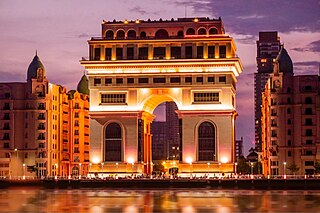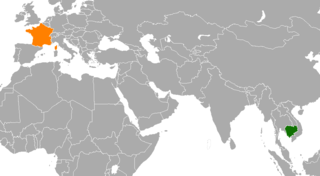
Kampong Speu is a province of Cambodia. It borders the provinces of Pursat and Kampong Chhnang to the north, Kandal to the east, Takéo to the southeast, Kampot to the south and Koh Kong to the west. Its capital is the town of Chbar Mon.

The Lycée français René Descartes de Phnom Penh is a private French school in Phnom Penh, Cambodia, operated under agreement with the Agency for French Education Abroad.

Phnom Penh International Airport is the busiest airport in Cambodia and serves as the country's main international gateway. It is Cambodia's second largest airport by area after the new Siem Reap–Angkor International Airport. It is located in the Pou Senchey District, 10 kilometres (5.4 NM) west of Phnom Penh, the nation's capital.

Soth Polin is a famous Cambodian writer. He was born in the hamlet of Chroy Thmar, Kampong Siem District, Kampong Cham Province, Cambodia. His maternal great-grandfather was the poet Nou Kan. He grew up speaking both French and Khmer. Throughout his youth, he immersed himself in the classical literature of Cambodia and, at the same time, the literature and philosophy of the West.

The Bunong is an indigenous ethnic group in Cambodia. They are found primarily in Mondulkiri province in Cambodia. The Bunong is the largest indigenous highland ethnic group in Cambodia. They have their language called Bunong, which belongs to Bahnaric branch of Austroasiatic languages. The majority of Bunong people are animists, but a minority of them follows Christianity and Theravada Buddhism. After Cambodia's independence in 1953, Prince Sihanouk created a novel terminology, referring to the country's highland inhabitants, including the Bunong, as Khmer Loeu. Under the People's Republic of Kampuchea (1979-89), the generic term ជនជាតិភាគតិច "ethnic minorities" came to be in use and the Bunong became referred to as ជនជាតិព្នង meaning "ethnic Pnong". Today, the generic term that many Bunong use to refer to themselves is ជនជាតិដើមភាគតិច, which can be translated as "indigenous minority" and involves special rights, notably to collective land titles as an "indigenous community". In Vietnam, Bunong-speaking peoples are recurrently referred to as Mnong.

Chau Sen Cocsal, also known as Chhum, was a Cambodian civil servant and politician who served as Prime Minister of Cambodia in 1962 and President of the National Assembly twice, in 1962–1963 and 1966–1968. He lived for 103 years, 143 days, making him the longest-lived state leader in the world with the known date of birth and death until 12 August 2023. Chhum was awarded the honorary title "Samdech" in 1993 by King Norodom Sihanouk.

Cambodia has 612 km (380 mi) of 1,000 mm metre gauge rail network, consisting of two lines: one from the capital Phnom Penh to Sihanoukville, and another from Phnom Penh to Poipet on the Thai border. The lines were originally constructed during the time when the country was part of French Indochina, but due to neglect and damage from civil war during the latter half of the 20th century, the railways were in a dilapidated state and all services had been suspended by 2009. Through rehabilitation efforts by the Government of Cambodia, with funding from the Asian Development Bank, Australian Agency for International Development (AusAID) and Australian company Toll Holdings, freight and limited passenger service returned between Phnom Penh and Sihanoukville by 2016, and passenger service between Phnom Penh and Poipet was fully restored in 2019.

Royal Air Cambodge was the flag carrier airline of Cambodia, headquartered in Phnom Penh.
Cambodia used the postage stamps of Indochina until the early 1950s. In 1949 Cambodia became an associated state of the French Union but gained independence in 1953 and left the Union in 1955.

Diamond Island is a satellite city in Phnom Penh on the Mekong and Bassac rivers.

Boeung Kak is an area in Khan Daun Penh and Khan Toul Kourk centrally located in the capital city of Cambodia, Phnom Penh. Until around 2010, it was covered by the largest urban lake in Phnom Penh. Residential areas, businesses, restaurants, hotels, embassies and other local businesses surrounded the area of the lake. Phnom Penh's main railway station formerly sat on its south coast. The lake itself was 90 hectares in area.
The Lower Se San 2 Dam is a hydroelectric dam under development on the Se San River in Stung Treng Province, northeastern Cambodia. The Se San River is a major tributary of the Mekong River. The dam site is located 25 kilometres (16 mi) east of the provincial capital, also named Stung Treng. The first turbine began producing electricity in November 2017. The dam was officially opened on December 18, 2018.
The Stung Treng Dam is a proposed hydroelectric dam on the Mekong River in Stung Treng Province, Cambodia. It would be located on the mainstream of the Lower Mekong River. The project is controversial for several reasons, including its possible impact on the fisheries, as well as other ecological and environmental factors.
This page describes energy and electricity production, consumption and import in Laos.

Cambodia–France relations are the bilateral relations between the Kingdom of Cambodia and the French Republic. Cambodia was a protectorate of France from 11 August 1863 to 9 November 1953. King Norodom approached the French in 1861, in an attempt to stop neighbors Thailand and Vietnam from swallowing Cambodia's land.

NagaCorp Ltd. is a Hong Kong-listed hotel, gaming and leisure company. Its Cambodian property, NagaWorld, is the country's largest hotel and gaming resort, and is Phnom Penh's only integrated hotel-casino entertainment complex. NagaCorp holds a 70-year casino licence in Cambodia which runs until 2065, and has a monopoly within a 200-kilometre (120 mi) radius of Phnom Penh until 2045.

A small tree with tortuous twigs, Dillenia pentagyna is a member of the family Dilleniaceae, and is found from Sulawesi to South-Central China to India and Sri Lanka. Material from the tree has some minor uses.

Wat Vihear Suor is a Theravada Buddhist temple located in Kandal Province, Cambodia. It was built on an older pre-Buddhist cult site belonging to the Angkor era.
The Embassy of France in Cambodia is the primary diplomatic mission of the French Republic to the Kingdom of Cambodia. It is located in the capital Phnom Penh. It is known for the role it played as a place of refuge for foreigners and at-risk Cambodians after the Khmer Rouge takeover for several days until foreigners were forced to go to Thailand while the regime forced Cambodians to stay in the country.
The 2022 Hun Sen Cup was the 16th season of the Hun Sen Cup, the premier knockout tournament for association football clubs in Cambodia involving Cambodian Premier League, Cambodian League 2 and provincial football clubs organized by the Football Federation of Cambodia (FFC). The competition was split into 2 stages, the provincial stage which started on 8 February 2022 and the national stage with the top four teams from provincial stage entering the play-off of national stage, competing with the teams from Cambodian League 2.














